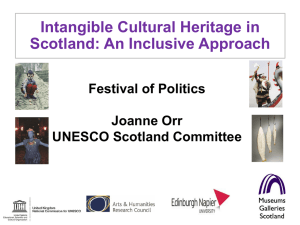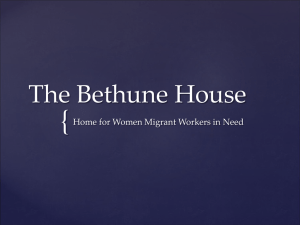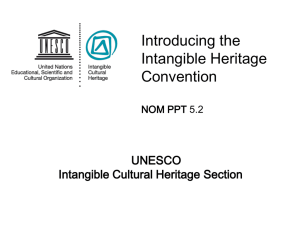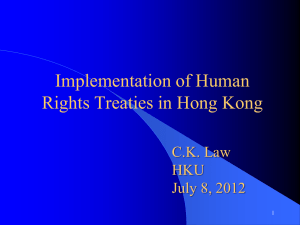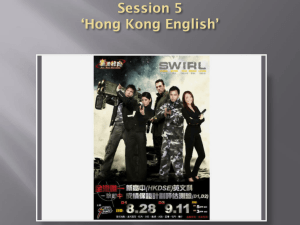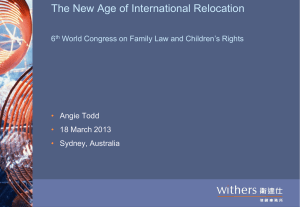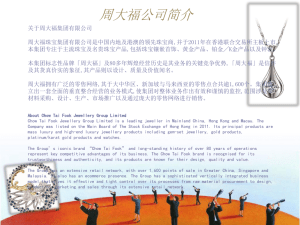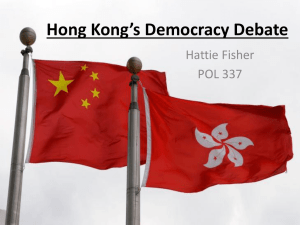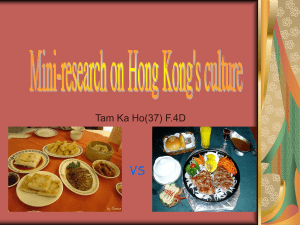香港的非物質文化遺產保護工作
advertisement
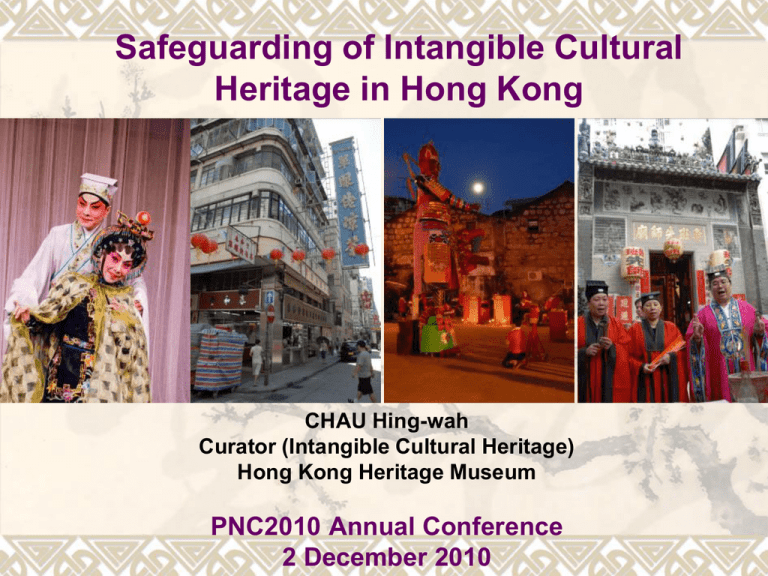
Safeguarding of Intangible Cultural Heritage in Hong Kong CHAU Hing-wah Curator (Intangible Cultural Heritage) Hong Kong Heritage Museum PNC2010 Annual Conference 2 December 2010 Convention for the Safeguarding of the Intangible Cultural Heritage 保護非物質文化遺產公約 Adopted by UNESCO in 2003 People’s Republic of China decided to ratify the Convention in August 2004 Government of Hong Kong Special Administrative Region (HKSAR) agreed that the Convention should apply to the HKSAR with effect from 7 December 2004 Institutional Establishment 保護機構 Home Affairs Bureau is the policy bureau responsible for the preservation of the ICH Leisure and Cultural Services Department (LCSD) is the executive department Institutional Establishment March 2006, a new ICH Unit was set up under the Hong Kong Heritage Museum July 2008, the Secretary for Home Affairs appointed an ICH Advisory Committee(非物質文 化遺產諮詢委員會) Inventory-making 清單 Article 12 – Inventories 1. To ensure identification with a view to safeguarding, each State Party shall draw up, in a manner geared to its own situation, one or more inventories of the intangible cultural heritage present in its territory. These inventories shall be regularly updated. ICH Unit was tasked to conduct a territory-wide survey on the ICH in Hong Kong since 2006. The South China Research Center, Hong Kong University of Science and Technology was awarded in August 2009 the tender of conducting survey which should be completed in early 2012. Inventory-making 清單 Article 2 – Definitions The “intangible cultural heritage” is manifested inter alia in the following domains: (a) oral traditions and expressions, including language as a vehicle of the intangible cultural heritage; (b) performing arts; (c) social practices, rituals and festive events; (d) knowledge and practices concerning nature and the universe; (e) traditional craftsmanship. Long and Diversified Hong Kong Culture Hong Kong’s history can be traced back to the late Palaeolithic of some 30,000 years ago Since Song and Ming dynasties, clan lineages gradually established in Hong Kong During the colonial period, Western cultures have strong influence in Hong Kong Palaeolithic Period The stone artefacts from the Wong Tei Tung (黃地峒) site, Sai Kung are dated to some 30,000 years ago Neolithic Period (5000 – 1500 BC) Tung Wan Tsai, Ma Wan 馬灣東 灣仔北遺址 Bronze Period 青銅時代 Qin and Han (221BC - 220AD) Lei Cheng Uk Han tomb 李鄭屋漢墓 Song and Ming dynasties (960 – 1644) people moved from the north to the south Cantonese 廣府話 Hakka客家話 Wai Tau 圍頭話 Tanka 疍家話 Hoklo 福佬話 Ancestral halls of clan lineages Clan traditions Dim-tang ritual 點燈儀式 Ma Tin Village 馬田村點燈 2010 Spring ancestral offerings Spring ancestral offerings in Sheung Shui 上水廖族春祭 Spring ancestral of Tang clan in Fanling After lifting of coastal evacuation order in early Qing, Hakka and Hoklo people were encouraged to move to Hong Kong 清初康熙遷海之後,客家人、鶴佬人 遷移沿海地區 Tin Hau Festival 元朗大樹下 天后誕 (三月廿三日) Tin Hau Festival in Tsing Yi 青衣天后誕 Sai Kung 糧船灣天后誕 Hung Shing Festival 滘西洲洪聖誕 (二月十三日) 滘西洲洪聖誕 Dragon boat parade, Tai O 大澳端午遊涌 Receiving the deities 請神 Deities boat 神艇 Water parade 遊涌 Yu Lan Ghost Festival of Chiu Chow Community 銅鑼灣 摩頓台 潮人盂蘭勝會 Yu Lan Ghost Festival of Guangdong community in Central Yu Lan Ghost Festival of Hoklo community on Ping Chau 坪洲 鶴佬盂蘭 勝會 Fire Dragon Dance, Hakka Community in Tai Hang 大 坑 中秋 舞火龍 Jiao-festival, Cheung Chau 長洲太平清醮 長洲北帝廟 Pak Tai Temple, Cheung Chau 1999年太平清醮期 間長洲北帝廟前舞獅 Lion dance in front of Pak Tai Temple during the Bun Festival, 1999 請北帝神像巡遊及看戲 Bringing the Pak Tai to parade and watch Cantonese opera 2009年長洲太平清醮醮場 The ceremonial area of Bun Festival, 2009 建造包山 Constructing bun mountains Toaist rituals 喃嘸法事 粵劇神功戲 Cantonese opera performance 飄色,1950年代 Parade of Floats, the 1950s 1970 1980 2007 太平清醮儀式結束後,工作人員從包山除下平安包,分給島上居民 Removing buns from the bun towers for distribution to the villagers after the ceremony Jiao-festival of Man Clan, Tai Po 大埔泰亨文氏 太平清醮,五 年一屆 打武 祭大幽 Burning of the ghost king 祭大幽 Jiao-festival, Kat O 吉澳太平清醮 十年一屆 Jiao-festival, Aberdeen 香港仔水面醮 每年舉行 Colonial Rule 英人統治 In 1841, Charles Elliot ordered that all the Chinese traditions, rituals and practices would be respected and allowed. 義律 (Charles Elliot) 即於1841年初向居港華 人發出文告,表明「所 有禮儀所關、鄉約律例、 率准仍舊」 傳統承傳 Man Mo Temple, Autumn offering by the Tung Wah Group Western culture and tradition 西方傳統文化傳承 St. John Cathedral 聖約翰座堂 Catholic tradition 基督教傳統 聖瑪加利大堂 Catholic tradition on Yim Tin Tsai 鹽田仔天主教傳統 Jewish tradition 猶太教傳統 Muslim tradition 回教傳統 Hindu tradition 印度教傳統 Hindu festival 印度十勝節 印度十勝節 Territory-wide Survey and ICH Database 非物質文化遺產普查和數據庫 Desk-top researches Field survey: 1. discussion with local informants to establish the locality, timing, event programme and bearers of the ICH; 2. oral history survey with the identified ICH bearers; 3. photographic and video recording; and 4. collection of instruments, objects, artifacts and documents associated with the ICH items. Access to ICH Database: Copyright and Data Privacy 非物質文化遺產數據庫:版權和私隱 Article 13 Each State Party shall endeavour to… (ii) ensuring access to the intangible cultural heritage while respecting customary practices governing access to specific aspects of such heritage; (iii) establishing documentation institutions for the intangible cultural heritage and facilitating access to them. Access to the ICH database is, however, governed by the Copyright Ordinance and Personal Data (Privacy) Ordinance in the Hong Kong. Intellectual Property Rights in ICH Potential intellectual rights include patents, registered designs and trade secrets. Patents: formula of a Chinese medicine. Trade secrets: formulae, methods, technologies, designs that have commercial value such as herbal tea drinks. ICH may lose protection under the existing IPR system as a result of disclosure. Surveyors must obtain from those communities the prior and informed consent before their ICH is inventoried. Authorization form. Safeguarding Measures 保護措施 Identification, documentation, research, preservation, protection, promotion, enhancement, transmission, particularly through formal and non-formal education, as well as revitalization 確認、立檔、研究、保存、保護、宣 傳、弘揚、承傳(主要通過正規和非 正規教育)、振興 Thank you 謝謝
